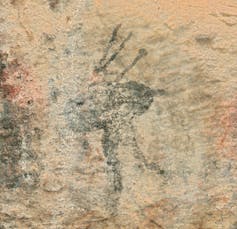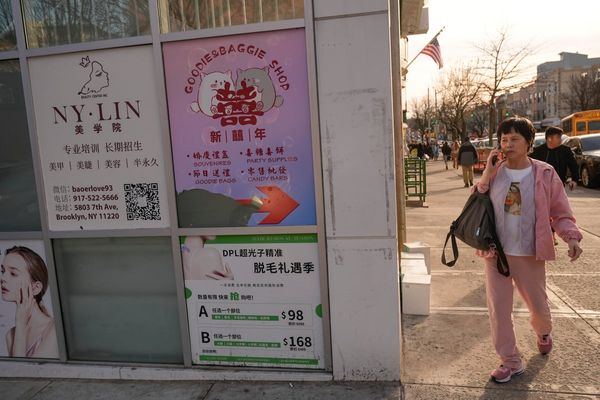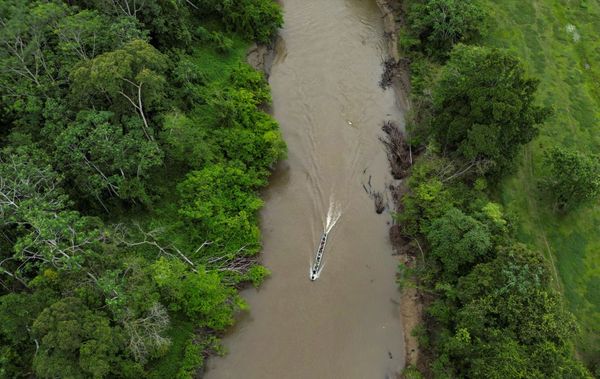
To “read” the history of times before writing, scholars have traditionally used excavated evidence. Remains like dwellings, burials and pots can reveal a lot about how people lived long ago. In southern Africa, there is another archive to “read” too: rock art. Rock art is primarily a record of spiritual beliefs – but also reflects the events that these beliefs made sense of.
Hunter-gatherers in the region, ancestors of today’s San or BaTwa, made rock art for thousands of years before African herders and farmers arrived from the north 2,000 years ago and European colonists followed by sea 350 years ago.
As a result of these contacts between groups of people, ethnic and economic boundaries became increasingly blurred. Rock art changed too, in technique and subject matter.
Rock art tells a tale of people meeting, negotiating, fighting, trading with and marrying one another. The tale is told not in simple narrative, but in spiritual beliefs. Our recent paper in Current Anthropology outlines the nature, scale and effects of contact between people in southern Africa, and the ways in which indigenous people produced images that engaged with change. It shows that contact and colonisation, in time, created a “disconnect” with the past that can be understood by looking at changes in rock art.
The disconnect apparent in the rock art reflects the disconnect in indigenous society more generally. It reveals the mixing and changing – and survival – of different people’s beliefs about the universe. It charts southern African history and, although it is “written” in terms of spiritual beliefs, it is the only record that shows what happened from the San perspective.
It often shows the struggle to resist subjugation, and it depicts beliefs about the forces that could be summoned to resist.
Shifts in rock art
What the San painted or engraved on rock was their vision of what happened in a trance state. The artists entered this trance state in order to establish connections with animals and spirits in the landscape, to influence their movements, and to derive the power to make rain and heal the sick.
Rock art was never unchanging, but new traditions and styles appeared when African farmers arrived in southern Africa from about 2,000 years ago, and when pastoralism was later introduced. Further changes came with the arrival of Khoe-speakers about 1,000 years ago. These Khoe-speaking herders were themselves descended from earlier mixing between hunter-gatherers and east African pastoralists.
Changes appeared in the rock art’s content – for example the animals and materials portrayed – and in the artistic techniques used.

Eland antelope (the one with the most spiritual power for the San) were once lovingly drafted and shaded. Later they appeared in bright, chalky and vivid colours, rendered in a posterlike and blocky fashion. The drop in pigment quality was likely due to the breakdown of trade networks brought about by marginalisation, then slaughter, of indigenous people, but still they called on the power of the eland to help them.
We see pictures of cattle and sheep appearing in rock art, and finger-painted and engraved patterns associated with girls’ initiation, common to pastoralist and hunter-gatherer societies. The images show that people’s identity (ethnicity) and the way they survived (economy) weren’t divided into clear groups. Hunters were not necessarily all San, and all San were not necessarily hunters. The blurring of boundaries between groups increased with time.
As time went on, all these people became subject to extermination policy, slavery and marginalisation. But rather than being passive receptors of change, they used their religion, comprising multicultural beliefs, to survive. This can be seen in the rock art they created.
Spiritual concepts of water
Conceptions of the rain, in the form of images of water bulls and water snakes, are particularly useful for examining cross-cultural influences.
For African farmers, snakes were associated with water. Hunter-gatherers and herders with whom they came into contact acknowledged this because they, too, already had beliefs about water and the animal entities embodied by it.
People from different language groups may have gathered together for girls’ initiation ceremonies at sites where the great water snake emerged. At these locations, this spiritual creature’s body, the undulating rock, is covered with markings to appeal to it – the markings that also appear on the initiates’ tattoos, face paint, clothing and bags.
The control of water, to make rain for pasture and crops, was traded (bartered for cattle) between groups, very likely for centuries. Rock art images of water snakes, water bulls and domestic cattle intertwine and superimpose one another; sometimes water snakes have cattle horns. Often, water bulls or water snakes were depicted being killed to make their blood – the rain – fall.
Water was also extremely important to those wishing to combat the encroaching colonists. By this time the people of southern Africa, regardless of background, held many beliefs in common. The people or entities that lived underwater could be called upon to influence situations: torrential rain to wash away the tracks of stolen animals, for example.
Raiding and escape
By the time colonists arrived, hunter-gatherers had sheep, and isiNtu-speakers (African farmers) had adopted aspects of hunter-gatherer beliefs, and vice versa.

San were increasingly marginalised from well-watered pasture suitable for domestic herds of African herders and farmers. Some became herders themselves, some mixed with farmers and some became raiders. Then, with the expansion of settler farms in the 18th century (which they also raided) they were decimated, hunted and enslaved.
In the rock art, baboons became a symbol of protective power to enable raiders to escape unharmed. The root of a powerful medicine, so-|oa or mabophe – closely associated with baboons – enabled stock thieves to pass unnoticed, and “turned bullets to water”. We see this in the paintings of people taking on the power and features of baboons, appearing alongside horses and cattle.
Read more: South Africa's bandit slaves and the rock art of resistance
Horses, the magical vehicles of violence, passage and escape, were kept and cared for by their new owners – the raider groups. They painted themselves in scenes before, during and after raids, not as a diary entry but as part of the [ritual] of ensuring the outcome was favourable and the memory made positive.
We can now see changes in rock art, from “traditional” animals like rhebok and eland, to those showing rain bulls being killed, rain snakes captured, people with shields and spears, or riding horses alongside baboons, in a new light.
Sam Challis receives funding from the South African NRF African Origins Platform and is a member of the Bradshaw Foundation Rock Art Network
Brent Sinclair-Thomson received funding for this research from the South African National Research Foundation African Origins Platform.
This article was originally published on The Conversation. Read the original article.







